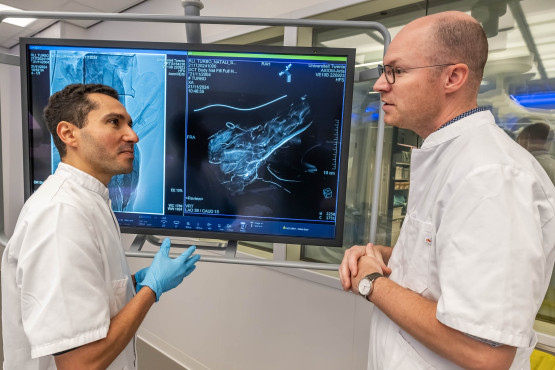The operating room in UT Twente’s TechMed Centre is the scene of an unusual sight this morning: a severed sheep’s head lies in a plastic tray on the operation table, while different transparent blood-filled hoses, stick out the neck. The hoses are connected with the brain’s arteries and supply it with a steady flow of the sheep’s blood to mimic the brain of a live animal. Several people of Khalil’s team are looking at different screens, where a 3D network of the sheep’s brains vessels is visible. Another screen shows an X-ray of the head, and the vertebrae can clearly be seen. ‘We used a CBCT scan to make this 3D image of the blood vessels’, Khalil explains. ‘Now we can determine the route that the micro-bot will travel inside the brain.’
Then, everything is ready for the  experiment. Carefully, one of the team members picks up a 2-3 millimeter sized micro-bot using tweezers, and puts in one of the plastic tubes. Through the transparent tube, the bot can be seen as a sharp end of a small screw. Using a handheld magnet, he then directs it from the tube into the arteries. Once inside the artery, a powerful magnet, attached to a robotic arm takes over and directs the bot deeper inside the brain. In the neighboring room, the team follows the bot’s journey inside the brain using X-rays.
experiment. Carefully, one of the team members picks up a 2-3 millimeter sized micro-bot using tweezers, and puts in one of the plastic tubes. Through the transparent tube, the bot can be seen as a sharp end of a small screw. Using a handheld magnet, he then directs it from the tube into the arteries. Once inside the artery, a powerful magnet, attached to a robotic arm takes over and directs the bot deeper inside the brain. In the neighboring room, the team follows the bot’s journey inside the brain using X-rays.
Steady hand
Vascular diseases are the number one cause of death in the world, accounting for 13% of the total mortality, or over 9 million deaths per year. In the brain, strokes and brain aneurysms, the weakening and ballooning of blood vessels, are among the most critical neurological conditions, often resulting in severe disabilities or fatalities. Treatments of these conditions require precise and minimally invasive treatment, where the surgeon makes a small cut in the patient’s blood vessel to insert a thin, flexible wire. This catheter is then manually directed to the desired location, to treat the problem location, for example an obstruction. It requires a steady hand and a lot of skill of the medical professional. In humans, the length of the vascular network exceeds 100.000 kilometer, more than twice the circumference of the earth, and catheters obviously can’t reach every possible site of vascular obstruction. ‘Using a catheter has brought a lot of progress in the treatment of cardiovascular diseases’, Khalil says. ‘But sometimes the inserted wire is too long and too flexible, requiring more pushing force, resulting in more friction.’ There are tradeoffs between stiffness, diameter, and controllability. These compromises sometimes result in reduced control and accuracy and an increased risk of tissue damage, while also reaching the smallest vessels is challenging. Therefore, physicians are very keen on having improved treating tools available that are less invasive and offer improved patient outcomes.
'Our micro bot literally floats like a spaceship in the vascular system'
Improve accessibility
Getting rid of wires by using a remotely operated device, would improve the accessibility and treatment of the vascular system hugely. This is exactly what Khalil and Warlé and their teams are developing: a tiny, micro-sized robotic, screw-shaped device, equipped with an even smaller magnet, that literally swims through the vascular system, propelled by powerful magnets outside the body. ‘Our bot is literally floating like a space ship in the arterial system, while it spins around it’s long axis, moving like a tiny propellor’, Khalil explains. ‘The magnets give us full control over the bot, and we can swim with and against the blood flow, while following its exact position in real time using X-ray fluoroscopy images. We can even make the bot take turns, or reverse its direction of motion. We have access to the whole vascular system. And since we can use animal parts from the slaughter house, we don’t need extra experimental animals for our research yet!’
Swimming capabilities
The scientists successfully tested their bot in artificial arteries first, to test the swimming capabilities and control through powerful magnets. Then, Khalil and Warlé performed tests in a real aorta and kidneys, together with colleagues from RAM, and blood lab, LipoCoat and MESA+. ‘We deployed a 2 millimeter-large bot in an 8-12 millimeter aorta, and directed the bot into the renal artery, that was only 4 millimeter in size’, Khalil explains. ‘We followed the bot using X-rays images and successfully managed to control the bot and could easily steer it from the aorta into the renal artery.’
Major impact
When fully developed, the applications of the method are huge. Michiel Warlé, is enthusiastic, ‘It’s super cool’, he says. ‘It could have a major impact on treating blood clots in many organs, especially in the brain’. He claims that the bots are also safer than current catheter technologies, especially for treating lung embolies, where there is a large risk of damaging the tissue and subsequent bleeding. Warlé is impressed how the micro-bot can be manipulated very accurately, even in the smallest vessels, enabling treatment of blood clots deep inside the brain. He already is thinking how to use the technology in such cases: ‘When the location of the blood clot is accurately determined using a CT scan, AI could plan the quickest route through the blood vessels’, he says. ‘We can equip the micro-bot with some kind of umbrella, with barbs, that can hook the blood clot, and literally pull it back, removing the obstruction’.
Cancer treatment
Besides removing blood clots, the technology can also be applied for extremely accurate delivery of medication on specific locations, for example in cancer treatment. Warle: ‘We could direct a biodegradable bot, equipped with radioactive anti-cancer medication, exactly at the tumor side. The same can be done for lung embolies, by inserting a micro-bot, with blood-dissolving medication, inside the blood clot.’ This will be more effective, and result in substantially less side effects.
Meanwhile, in the operating room, the experiment on the sheep’s head is progressing, despite a few hurdles. On the screen, the bot, visible as a small black dot, seems to be stuck near a branching blood vessel. But manipulating the magnet a few times over the bot releases it quickly, solving the problem, whereafter it can continue it’s exciting journey in the sheep’s brain.











